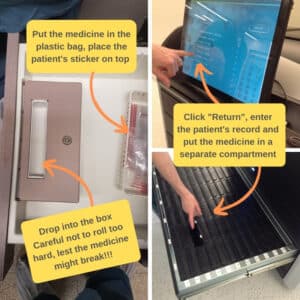As narcotics storage solutions for evolve and enter the surgery setting, there is a big focus on safeguards at the point of issue. However, the returns process seems to be an afterthought.
Drawn-out drug returns processes lack tight controls and are a drain on clinicians’ time, compromising security and accountability.
Surely there’s a better way?
The return of controlled drugs and narcotics after surgery
Not all drug ampoules and vials issued for a procedure end up being administered, so post-surgery reconciliation needs to account for damaged, wasted and unopened medications.
In many hospitals, decentralized dispensing in procedural areas means that clinicians lead on the dispensing and returns process.
After surgery, the gap between drug issue and administration needs to be closed. Every item issued needs to be accounted for on the patient record.
Controlled drugs need to be fully tracked to meet regulatory requirements, ensure personal accountability and lower the risk of drug diversion. It’s important! So why are so many drug returns processes so complicated and inefficient?
The traditional drug-return process is painful
Post case reconciliation processes (PCR) have a reputation for being painful, with many involving inefficient steps such as:
- form filling
- manual searches
- data entry
- label print-outs
- wrapping labels around returns
- bagging returns
- putting all items in the same external returns bin
- items breaking after they’ve been dropped in the returns bin
- gaining authorized signatures
- witnesses having to be present
- systems that aren’t PCR-enabled
- duplicating data to update hospital systems
- limited historical records
And this is for every unused item!
These long-winded workflows are time consuming and susceptible to human error.

Discrepancies in the Narcotics Inventory
Because the returns process is long-winded and inefficient, system reports often identify discrepancies in the narcotics inventory.
System data may show that items were issued but not used or returned, creating uncertainty as to their current location.
Busy clinical staff end up spending too much time on drugs reconciliation, but the truth is that it’s more effective to accurately record returns during PCR, than it is to reconcile meds later on.
The IDENTI Narcotics Cabinet – full tracking of issues and returns
The Narcotics Cabinet provides hospitals with an automated management system that delivers fully compliant drug dispensing and tracking in the surgery setting.
The cabinet ensures controlled drug accountability and discourages diversion, by recording each individual drug pull-out and return. It provides a digital link between the dispensed item, the case and the physician/anesthetist.

How the IDENTI Narcotics Cabinet manages post-surgery drugs returns
Digital recording of returns:
IDENTI’s Narcotics Cabinet completely eliminates the need for manual documentation of drug returns.
No notes, no printouts, no bagging – just a simple, digital process.
Post-surgery the physician’s original medication log can be used to digitally record damaged, wasted and unused returns. This quick on-screen process synchs to the EHR, ensuring the accurate documentation of medication.
Physical drug return:
Once the data has been entered, the system allocates a specific cell for each returned item. The physician is then signposted by on-screen prompts and guiding lights to relevant drawer and the unlocked cell, so that the medication can be placed inside.
The physical return of the drug, along with its digital footprint, are both associated with the dispensing physician and the case.
The drug is recorded as a return and placed back in the Narcotics Cabinet, ready for the pharmacist to validate. And that’s it. Job done.
Wasted items can also be logged on the system and then destroyed according to local protocol.
Security and Accountability
The Narcotics Cabinet gives full transparency, making sure each physician is accountable for their dispensing.
The pharmacist checks the returns drawer, verifying that each returned item matches the details logged on the system. In this way pharmacists retain ultimate control, validating and authorizing all returns and ensuring that each returned item is safely returned into stock.
The IDENTI Narcotics Cabinet’s precise yet simple returns process leaves no room for error.
The Narcotics Cabinet provides a quick and accountable way to dispense, track and return narcotics – contact us for a demo.








